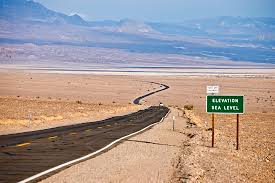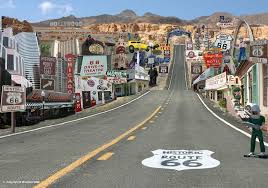USA Driving Advice and Car Hire Info
Driving Licence and Road Rules
USA drives on the right hand side of the road and legally, all you need in order to drive in the country for up to 3 months is a valid driving license issued by your own country. The exception to this is Georgia, which required your own licence plus and International Driving Permit. However, if your licence isn’t written in Roman alphabet, it would be worth obtaining an IDP before leaving your country as this will include an English language translation. Also, a number of car rental companies are now asking for an IDP in addition to a regular licence so check this before travelling. Speed limits vary by state and range from an 20 mph (32 km/h) in urban areas up to 85 mph (137 km/h) on certain freeways. On average limits are 70mph on rural freeways, 55-65mph on urban freeways and rural undivided highways and 30mph in built up areas.
USA Road Network
The USA road network comprises of approximately 4.3 million kilometres of paved roads with 76,000 km of motorways/freeways and 2.28 million kilometres of unpaved roads. The US Highway system uses the same numbering system throughout the country – Major routes have one or two numbers after the letters US. Most north-to-south highways are odd-numbered, with the lowest numbers in the east, and the highest in the west. Highways which run East-to-West across the country are usually even-numbered, with the lowest numbers in the north, and the highest in the south. Three-digit numbered highways are smaller roads linked to main highways. Roads are generally in excellent condition throughout the country, especially main routes which are heavily used and well maintained.
There are a large number of toll roads in most states which may include whole roads, sections of road or high-occupancy toll (HOT) lanes, express toll (ETL) lanes, and high occupancy vehicle lanes.(HOV). Tolls are usually administered by individual states so will there will be multiple ways to pay, including toll gates, pre paid passes and transponders in vehicles. Rental vehicles should have a transponder or pass to use in their home state but may not cover tolls in other states. Let the rental company know where you intend to travel and ask their advice on toll payment. There are also a number of toll-trip-planner apps available, such as this one – https://www.tollsmart.com/



Driving in USA
It could be argued that the USA is the ultimate ‘driving abroad’ location. The country is huge, with unlimited sights to see, and as a relatively ‘young’ country is probably more car friendly than anywhere else on earth. Roads are usually in excellent condition, even in remote areas, though the vast distances encompass numerous different climates and terrains which all present their own challenges.
You should research the area you’ll be visiting before setting off so you know what to expect, whether that’s the likely cost of toll roads, which roads in the mountains get cut off by snow at which times of year or escape routes in the event of a hurricane. American cities are usually set out in a grid formation with numbered streets which makes destination finding easier than in most countries. There are some anomalies however, with older Cities such as San Francisco being potentially more challenging. Also be aware that there are often potentially dangerous areas of cities quite close to the centre which are easy to stray into. Be on your guard and if you feel conspicuous while driving through an area just keep going until you reach a safe location such as a hotel or public building where you can stop and ask directions.
For travellers used to driving in Europe , driving in USA shouldn’t present many challenges. Speed limits are lower than in many countries, and American drivers tend to abide by road rules in most cases and drive at a sensible speed. In my experience they may hesitate when turning corners or approaching junctions so give them more room than you would a driver at home. Away from cities, roads tend to be long, straight and smooth and the biggest risk is that you’ll put your foot down and get caught for speeding (I speak from experience!). Sometimes using cruise control helps regulate your speed, as does checking the cars on the road around you- if you’re the fastest car, you’ll be the one to get stopped.
Some other differences you’ll experience – cars tend to be automatic rather than manual, and for UK visitors, the steering wheel will be on the left of the car. If you’ve never driven an automatic, ask the rental company to give you a quick demo- the golden rule is to only use one foot, tuck the other away behind you so you aren’t tempted to adopt a two footed approach! Another difference is that, if the way is clear, you can turn right at a red light. (That would be the equivalent of a left turn in UK ie you aren’t crossing the traffic coming towards you). This rule is potentially the only cause of impatience for US drivers –you’ll get a toot of the horn if you don’t move.In summary, driving in the USA is generally a great experience and easy for inexperienced visitors to handle. In my view, the biggest challenge is likely to be boredom on long journeys on straight roads as you fight the urge to put your foot down and do an extra 20 MPH!



America is a huge country and therefore the ‘norm’ is to take a flight between Cities, unless obviously you’re on a driving trip. Some distances and approximate driving distances between major cities and areas of interest are as follows-
Chicago to LA, (The start and end points for Route 66- for more detail see my Classic roadtrips page) -3300 km, 30 Hours
Chicago to New York -1300 KM, 13 hours
Chicago to Washington DC – 1130 KM, 12 hours
Chicago to Denver -1600KM, 15 hours
Denver to Las Vegas – 1200KM, 11 hours
New York to Washington DC – 370KM 4.5 Hours
New York to Boston -360KM, 4 hours
Washington DC to Orlando – 1370 KM, 13 Hours
Orlando to Miami -400KM, 4.5 Hours
Orlando to Memphis -1330KM, 14 Hours
Orlando to New Orleans- 1030KM , 10 hours
New Orleans to Houston -560KM, 5.5 Hours
Houston to Oklahoma City – 720KM, 7 hours
Houston to El Paso – 1200KM, 11 hours
El Paso to Phoenix -690KM, 6 hours
Phoenix to Las Vegas – 640KM, 6.5 hours
Phoenix to Los Angeles- 600KM, 6 Hours
Las Vegas to Los Angeles- 450KM, 4.5 hours
Los Angeles to San Francisco – 615KM, 6 hours
Las Vegas to San Francisco – 930 KM, 9.5 Hours
San Francisco to Seattle-1300KM, 13.5 Hours
Taking a vehicle from USA/Canada into Mexico
A number of travellers from the USA and Canada take their own vehicles into Mexico.The process for doing this depends on where you intend to take the vehicle. For most of the country, a temporary import permit is required. However, this is not required if you will remain within the Mexico Free zone or Border Zone. This is an area of between 20-26km from the Mexico’s Northern and Southern borders, plus the entire Baja peninsula and a large area in the Sonora region . In Sonora, the zone begins northwest of Mexico Federal Highway Number 2, starting at Agua Prieta. It then extends through Cananea, to where it intersects with Mexican Federal Highway 15 in Imuris. From Imuris, all of the areas to the north and west of Mexico Federal Highway 15 are included. The zone ends ar Kilometer 98, southeast of Empalme.
If travelling beyond the Border zone, a Temporary Vehicle Importation Permit (TIP) is required. This can be obtained at the border or online 7-60 days before travel from Banjercito, the official Mexican issuing agency. It is valid for any type of vehicle weighing less than three tons, for up to six months. The permit costs around $50USD plus a refundable deposit of between $200-$400USD. Documents required are – Passport, Driver’s License ,ownership documents or authority for a rental/lease vehicle to be exported, Proof of temporary Mexican car insurance.
Although I try and keep the information in the site updated as much as possible, in a rapidly moving world, situations can change daily. Therefore please use the site as an approximate guide, and in conjunction with other resources in order to form your view on driving conditions, roads, safety etc.
USA Car Rental –
Obviously in the home of the automobile, every international rental company is represented and USA features on all car rental broker sites.
We currently have no local car rental partners in USA. If you are a local car rental company who would like to feature on DriverAbroad.com please check details on our Partnering page or contact us on ADriverAbroad@Outlook.com
USA Self Drive Rules
You will usually be allowed to take rental cars into Canada but you should check this with the rental company when you make the reservation. There are likely to be restrictions on taking cars to Mexico and you may have to seek out a specialist rental company who allow this.




4 comments